A multifunctional use of bis(methylene)bis(5-bromo-2-hydroxyl salicyloylhydrazone): from metal sensing to ambient catalysis of A3 coupling reactions†
Abstract
The potential use of bis(methylene)bis(5-bromo-2-hydroxylsalicyloylhydrazone) as a multifunctional fluorescence sensor for Cu2+, Ni2+, Co2+ and Fe2+ ions was investigated. The optical behaviour shows an increase in an absorption band at 408 nm which can be ascribed to the d–d transition (UV-vis) of the metal ions and a concomitant decrease in fluorescence intensity at 507 nm. The crystallographic analysis shows the binding site of the sensor to two Cu2+ ions and confirms the stoichiometry of 1 : 2 (ligand to metal) which is in good agreement with a Job plot analysis. Furthermore the Cu2+-complex catalyses A3 coupling reactions at 1 mol% catalytic loading; chiral propargylamine derivatives were obtained in high yield after 24 h reaction time under ambient conditions.



 Please wait while we load your content...
Please wait while we load your content...